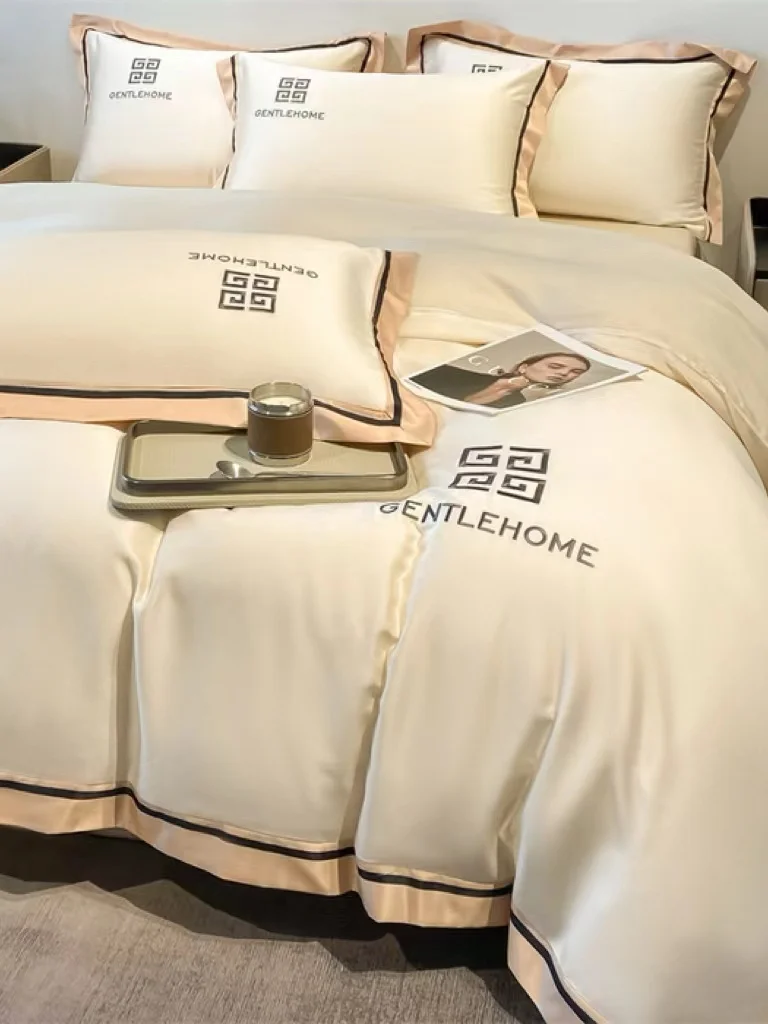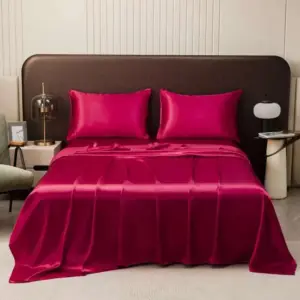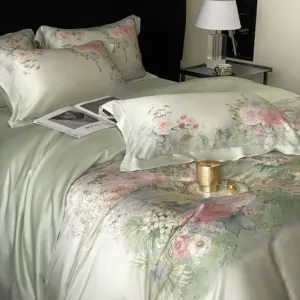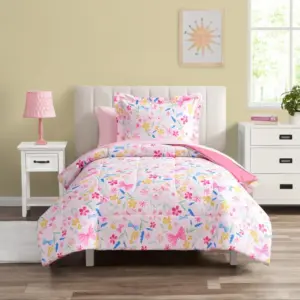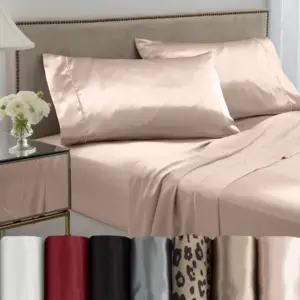Introduction: The Silk Sheet Dilemma – Luxury or Necessity?
For centuries, silk has been synonymous with luxury, elegance, and opulence. From the ancient Silk Road to modern bedrooms, this natural fiber has maintained its reputation as one of the most coveted materials for bedding. Yet, when faced with their premium price tag, many potential buyers find themselves wondering: are silk bedsheets truly worth the investment?
This is no small consideration. With quality silk bedding sets often costing several times more than their cotton counterparts, the question of value becomes significant. Are you simply paying for the prestige of owning silk, or do these lustrous sheets offer tangible benefits that justify their cost?
In this comprehensive analysis, we’ll examine the full spectrum of factors that determine whether silk bedsheets are a worthwhile investment. From their unparalleled comfort and surprising health benefits to potential drawbacks and maintenance requirements, we’ll provide you with all the information needed to make an informed decision tailored to your personal needs and preferences.
The true worth of silk bedding ultimately depends on how you prioritize factors like sleep quality, skin and hair health, temperature regulation, durability, and maintenance effort against your budget. What represents excellent value for one person might not for another. Exploring the ultimate guide to silk bedding can provide additional context for your decision-making process.
The Unrivaled Benefits of Sleeping on Silk: Why Many Say “Yes”
When considering the value proposition of silk bedsheets, it’s essential to understand their comprehensive benefits. These advantages extend far beyond simple luxury or status, offering tangible improvements to sleep quality, health, and overall well-being. For many satisfied owners, these benefits alone justify the higher initial investment.
Let’s explore the specific advantages that make silk bedsheets a potentially worthwhile investment, examining how each benefit contributes to the overall value equation. Understanding these silk bedding basics is crucial for making an informed decision.
Supreme Comfort & Luxurious Feel: The Sensory Experience
The immediate, most noticeable benefit of silk bedsheets is their extraordinary feel against your skin. Silk offers an unmatched smoothness that many describe as “sleeping on a cloud.” Unlike cotton, which can feel crisp or rough, silk provides a gentle, soft embrace that feels simultaneously substantial and weightless.
This natural fiber drapes perfectly over your body, conforming to your shape without restriction. The unique protein structure of silk creates a frictionless surface that allows for effortless movement throughout the night. Higher momme weights (22-25) provide a slightly heavier, more substantial feel, while lighter weights (19-21) offer a more ethereal touch.
Many users report that their luxury silk bedding sets deliver a sensory experience that transforms ordinary sleep into something truly special, elevating the entire bedroom experience.
Temperature Regulation: The Perfect Microclimate for Sleep
One of silk’s most remarkable properties is its ability to regulate temperature year-round. Unlike synthetic materials that can trap heat, silk is highly breathable and naturally temperature-adaptive.
In warmer weather, silk allows excess body heat to escape while wicking moisture away from your skin, keeping you cool and dry. During colder months, the same protein structure creates microscopic air pockets that trap warmth close to your body without causing overheating or night sweats.
This natural thermoregulation means you’ll spend less time adjusting blankets or flipping pillows seeking the cool side. For those who sleep hot or experience night sweats, silk bedsheets in hot weather can be particularly beneficial, creating an ideal sleeping microclimate regardless of season.
Revolutionary Hair & Skin Benefits: Beauty While You Sleep
The smooth surface of silk offers significant beauty benefits that many users find transformative:
- Dramatically reduced friction means less hair breakage, fewer split ends, and minimized frizz and tangles
- Decreased facial creasing helps prevent sleep wrinkles that can become permanent over time
- Lower absorption of natural oils means your skin and hair retain essential moisture
- Preservation of expensive night creams and serums that cotton might otherwise absorb
These benefits are especially valuable for those with sensitive skin, curly or textured hair, or anyone investing in anti-aging skincare routines. Mulberry silk sheets for sensitive skin provide particularly noticeable improvements for those with reactive skin conditions, making their higher cost easier to justify when considering the potential savings on beauty products and treatments.
Hypoallergenic Properties: A Sanctuary for Sensitive Sleepers
For allergy sufferers, silk bedsheets can be transformative. Silk naturally resists common bedroom allergens including:
- Dust mites, which cannot easily burrow into silk’s tight fiber structure
- Mold and mildew, which struggle to grow on silk’s naturally moisture-wicking surface
- Certain bacteria, thanks to the natural protein sericin found in silk fibers
Additionally, silk’s smooth surface is less likely to irritate sensitive skin than rougher fabrics. The hypoallergenic qualities of Mulberry silk bedding sets make them particularly valuable for those with allergies, asthma, eczema, or other sensitivities, potentially improving sleep quality dramatically for these individuals.
Durability & Longevity: The Long-Term Value Proposition
Contrary to popular belief, high-quality silk bedsheets are remarkably durable when properly maintained. While silk requires specific care, sheets made with proper construction techniques and appropriate momme weights (19-25) can last for many years—often outlasting cotton sheets despite their seemingly delicate nature.
Silk’s natural protein fibers are surprisingly strong, with each individual strand comparable in strength to a steel wire of similar diameter. Quality silk bedding typically maintains its appearance and feel far longer than synthetic alternatives, with minimal pilling, fading, or deterioration when cared for correctly.
This longevity transforms the initial investment calculation, as the cost-per-use decreases significantly over time. When considering the extended lifespan of properly maintained silk sheets, the higher upfront cost often represents better long-term value than repeatedly replacing lower-quality alternatives.
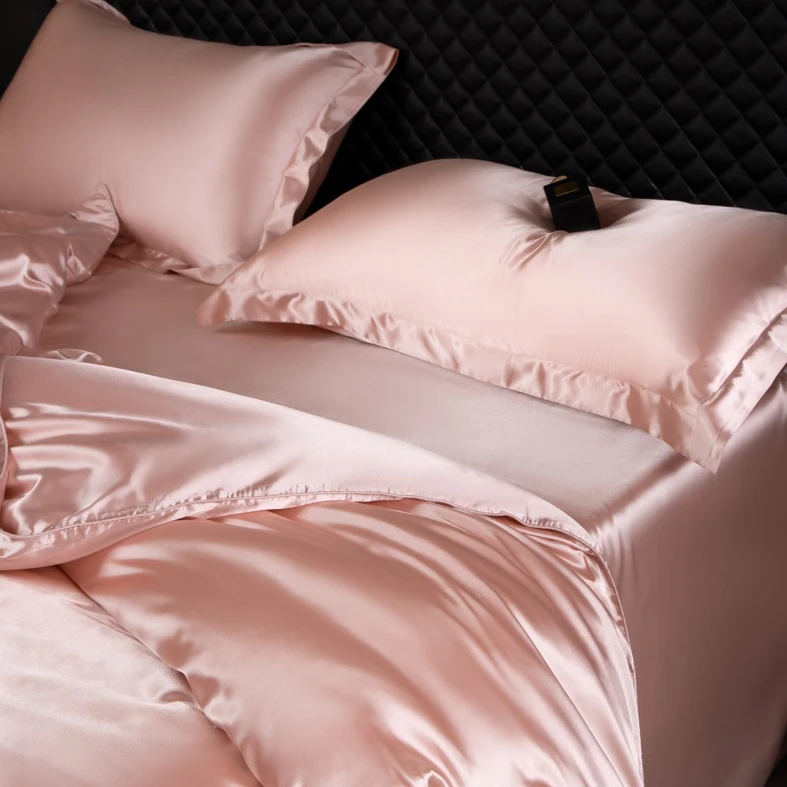
Aesthetic Appeal: Transforming Your Sleep Space
Beyond functional benefits, silk bedsheets transform the visual appeal of any bedroom. Their natural luster catches and plays with light in a way no other fabric can match, creating an undeniable sense of luxury and sophistication.
This natural sheen doesn’t fade with proper washing, allowing silk sheets to maintain their elegant appearance for years. The visual impact extends beyond aesthetics—studies suggest that creating a visually appealing, luxurious sleep environment can positively impact sleep quality and relaxation.
For those looking to create a truly special bedroom retreat, queen size silk bedding sets offer an immediate aesthetic upgrade that elevates the entire room, making the investment worthwhile from both functional and decorative perspectives.
Understanding the Challenges: Potential Drawbacks of Silk Bedsheets
Despite their numerous benefits, silk bedsheets aren’t the perfect choice for everyone. A balanced assessment requires honest consideration of potential drawbacks and challenges. Understanding these factors is essential when determining if silk sheets represent a worthwhile investment for your specific situation and preferences.
The following sections examine the primary challenges associated with silk bedsheets, providing perspective on how significantly these factors might impact your satisfaction and the overall value equation. For a more detailed exploration, you might consult the ultimate guide to luxury silk bedding which addresses both advantages and potential concerns.
The Price Factor: Initial Investment Considerations
The most obvious barrier to silk bedsheets is their cost. Quality silk sheet sets typically range from $300 to $1,000 or more for a queen size, depending on momme weight, silk grade, and brand reputation. This represents a significant premium over even high-quality cotton options, which might cost $100-300 for comparable sizes.
This higher initial investment requires careful consideration, particularly when comparing:
- 100% mulberry silk sheets versus silk blends or alternatives
- Different momme weights (higher generally means more expensive)
- Various construction techniques and finishing processes
- Brand reputation and quality guarantees
While the long-term value proposition often favors silk when calculated over years of use, the higher upfront cost remains a genuine consideration for many buyers. The question of whether silk bedding is worth the investment ultimately depends on your budget priorities and how highly you value the specific benefits silk provides.
Maintenance Requirements: The Care Commitment
Silk requires more attentive care than many other bedding materials. This maintenance commitment includes:
- Gentle washing using specialized silk detergents or mild soap
- Cold water only, with hand washing or delicate machine cycles
- No bleach, fabric softeners, or enzyme-based detergents
- Air drying away from direct sunlight
- Careful ironing with low heat settings if needed
For busy individuals or those who prefer low-maintenance bedding options, this care routine might feel burdensome. However, many find that the process becomes routine over time, and some manufacturers now offer washable silk sheets specifically designed for easier care while maintaining most of silk’s beneficial properties.
The Slippery Factor: Practical Sleep Considerations
Silk’s smooth surface, while luxurious, creates practical challenges for some sleepers. The natural slipperiness can cause:
- Sheets sliding or bunching during the night
- Pillows slipping out from under your head
- Duvet covers shifting inside their cases
These issues are particularly noticeable during the adjustment period when transitioning from cotton sheets. Solutions include using fitted sheets with deeper pockets and strong elastic, adding non-slip mattress pads, or selecting silk sheets with slightly textured weaves that reduce slippage while maintaining silk’s beneficial properties.
Many users find these challenges diminish as they adapt to sleeping on silk, but others may find the slipperiness persistently frustrating, particularly if they move frequently during sleep.
Vulnerability to Damage: Durability Considerations
While properly maintained silk is surprisingly durable, it remains vulnerable to specific types of damage:
- Snags from jewelry, rough skin, or pet claws
- Water spots from improper washing or spills
- Weakening from exposure to direct sunlight
- Potential yellowing over time (particularly with white or lighter colors)
- Damage from harsh detergents or improper washing
These vulnerabilities require mindfulness about how you interact with your bedding. Removing jewelry before bed, keeping pets off silk sheets, and following proper care instructions become important habits for preserving your investment.
Ethical and Sustainability Considerations: Beyond the Bedroom
Traditional silk production involves harvesting silk from cocoons, a process that typically ends the silkworm’s life cycle. This raises ethical concerns for some consumers, particularly those following vegan lifestyles.
For those with such concerns, several options exist:
- Peace silk (also called Ahimsa silk), which allows the moth to emerge before harvesting
- Vegan silk alternatives that mimic silk’s properties using plant-based or synthetic materials
- Certified organic silk produced with more sustainable and ethical practices
These alternatives often come with their own considerations regarding environmental impact, feel, durability, and cost, requiring careful evaluation of personal priorities when making purchasing decisions.
Material Showdown: How Silk Compares to Other Premium Bedding Options
To truly determine if silk bedsheets represent a worthwhile investment, it’s helpful to compare them directly with other premium bedding options. This comparison provides context for silk’s benefits and challenges, helping you assess relative value based on your personal priorities.
Let’s examine how silk measures up against its main competitors in the luxury bedding market, exploring specific differences in performance, feel, and value. For a more detailed analysis, you might explore our silk vs cotton bedding comparison.
Silk vs. Cotton: Natural Fiber Face-Off
Cotton remains the most popular bedding material, with premium varieties like Egyptian, Pima, and Supima offering their own luxury appeal. When comparing silk to high-quality cotton:
Feel and Comfort: Silk provides a smooth, frictionless surface that feels cool and weightless. Premium cotton offers a crisp feel in percale weaves or a smoother, heavier feel in sateen weaves, but still creates more friction against skin than silk.
Temperature Regulation: Both materials are naturally breathable, but silk excels at adapting to body temperature, feeling cool in summer and warm in winter. Cotton absorbs moisture well but can feel damp when saturated and doesn’t offer the same insulating properties in cold weather.
Durability: With proper care, high-quality versions of both materials can last for years. Cotton typically withstands more aggressive washing but may show wear through pilling or fading sooner than silk. Silk requires gentler care but often maintains its appearance longer when properly maintained.
Price Comparison: Quality cotton sheet sets typically range from $100-300, while comparable silk sets cost $300-1,000+, representing a substantial premium.
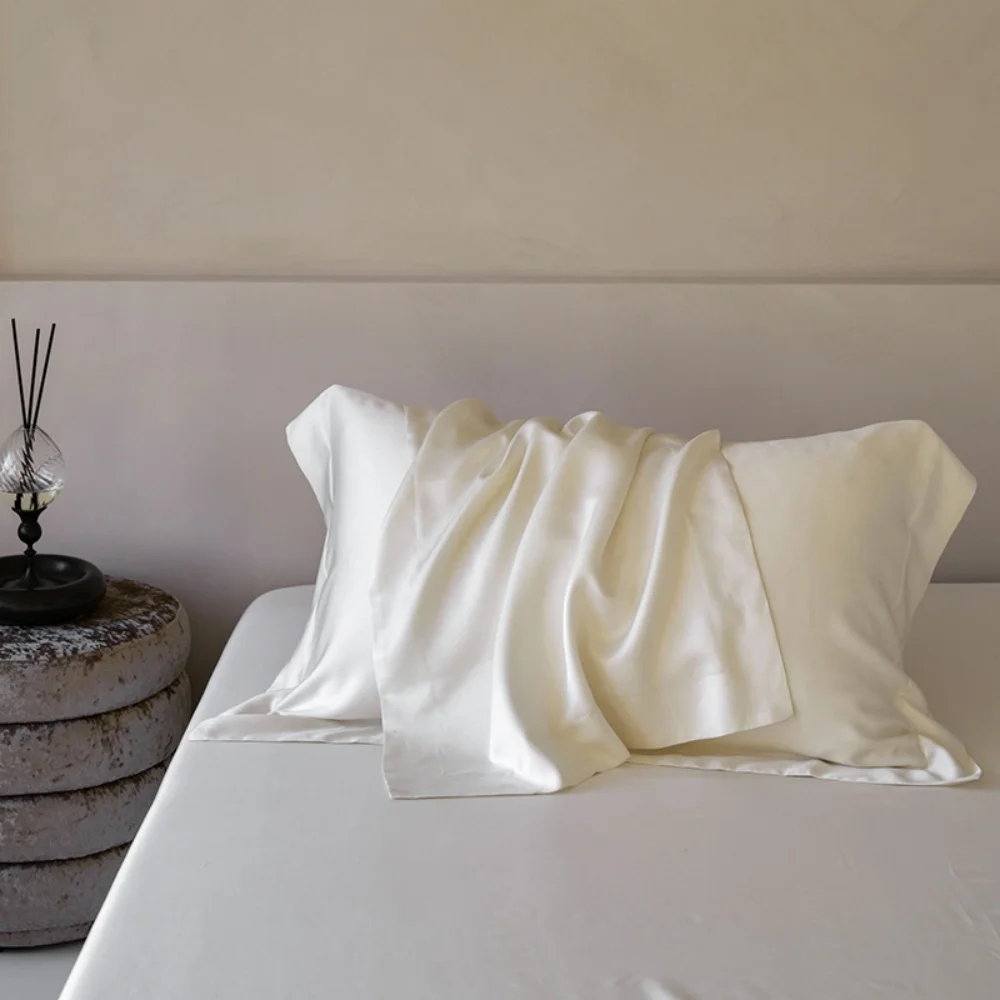
Silk vs. Synthetic Satin: Natural vs. Man-Made Luxury
Many consumers confuse silk (a natural fiber) with satin (a weave technique). Polyester satin sheets attempt to mimic silk’s appearance and smoothness at a lower price point.
Material Composition: Silk is a natural protein fiber, while satin sheets are typically made from polyester or nylon. This fundamental difference affects nearly all performance aspects.
Feel and Breathability: Synthetic satin initially feels smooth but often creates static and tends to trap heat. Silk offers natural breathability and temperature regulation that synthetics cannot match.
Skin and Hair Benefits: Silk’s protein structure provides genuine benefits for skin and hair. Synthetic satin provides reduced friction compared to cotton but lacks silk’s moisture-balancing properties and can actually increase static electricity that damages hair.
Longevity and Value: Quality silk lasts for years with proper care. Synthetic satin typically shows wear much sooner, with pilling, fading, and texture changes after fewer washings, requiring more frequent replacement.
Price Difference: Synthetic satin sheets typically cost $30-100 per set—significantly less than silk but with correspondingly reduced benefits and longevity.
Silk vs. Linen: Two Premium Natural Fibers
Linen has experienced a resurgence in popularity, valued for its relaxed aesthetic and excellent breathability.
Texture and Feel: Linen has a distinctive textured feel that softens with washing but maintains a characteristic roughness that some find appealing and others find irritating. Silk offers consistent smoothness from first use.
Aesthetic Appeal: Linen projects a casual, relaxed, somewhat rustic appearance with natural wrinkles being part of its charm. Silk presents a more formal, luxurious appearance with its natural sheen and drape.
Temperature Performance: Both excel at breathability and moisture-wicking, though linen performs particularly well in hot, humid conditions. Silk offers better insulation in cooler temperatures while still breathing well in heat.
Care Requirements: Both require special care, though linen is generally more forgiving of washing mistakes. Linen’s appeal often comes from its intentionally rumpled look, while silk typically requires more careful handling to maintain its smooth appearance.
Price Comparison: Quality linen sheet sets typically range from $200-500, placing them between premium cotton and silk in terms of investment.
Bedding Material Comparison Table: At-A-Glance Decision Guide
| Feature | Silk | Egyptian Cotton | Linen | Synthetic Satin |
|---|---|---|---|---|
| Average Price (Queen) | $300-1,000+ | $150-300 | $200-500 | $30-100 |
| Feel | Smooth, cooling | Crisp or soft depending on weave | Textured, becomes softer with washing | Smooth but can cause static |
| Temperature Regulation | Excellent: cool in summer, warm in winter | Good: breathable but less insulating | Excellent in heat, less insulating in cold | Poor: often traps heat |
| Moisture Wicking | Excellent | Good | Excellent | Poor |
| Skin/Hair Benefits | Excellent: reduces friction and maintains moisture | Moderate: depends on thread count and weave | Moderate: natural but textured | Minimal: reduces friction but causes static |
| Durability with Proper Care | 5-10+ years | 3-5 years | 5-10+ years | 1-3 years |
| Care Difficulty | High | Low to Moderate | Moderate | Low |
| Hypoallergenic | Naturally hypoallergenic | Varies | Naturally hypoallergenic | Not naturally hypoallergenic |
This comparison highlights silk’s unique position in the premium bedding market. While it requires the highest initial investment and most careful maintenance, it also offers unmatched benefits for skin, hair, temperature regulation, and hypoallergenic properties. The value equation ultimately depends on which of these factors matter most to you personally.
Identifying True Quality: The Silk Bedsheet Buying Guide
Not all silk bedsheets offer the same quality, performance, or value. Understanding how to identify genuine quality is essential when making this significant investment. The difference between exceptional silk sheets that last for years and inferior products that quickly disappoint often comes down to several key quality indicators.
This section will help you navigate the sometimes confusing world of silk terminology and marketing claims, ensuring you can make an informed decision. For more detailed guidance, consider exploring our ultimate guide to buying luxury silk bedding.
Decoding Momme Weight: Silk’s Quality Metric
Momme (pronounced “mummy”) weight is to silk what thread count is to cotton—the primary indicator of fabric density and quality. This measurement represents the weight in pounds of a piece of silk measuring 45 inches by 100 yards.
For bedding, the ideal momme range falls between 19-25:
* 19-21 momme: Lighter, more breathable, slightly more translucent, excellent for hot sleepers
* 22-25 momme: More substantial feel, greater durability, less translucent, typically more expensive
Sheets below 19 momme often lack durability for regular use, while those above 25 momme may feel too heavy for comfortable sleep. Most premium bedding manufacturers, including Sanctuary Soft, focus on the 22 momme silk sheets range, which offers an optimal balance of durability and comfort.
When shopping, be wary of listings that don’t specify momme weight—this omission often indicates substandard quality. Quality manufacturers proudly display this specification as a mark of transparency and confidence in their product.
Understanding Silk Grades: From 6A to 2A
Beyond momme weight, silk is graded on a quality scale ranging from 6A (highest) to 2A (lowest commercial grade), though this system is less standardized than momme measurement.
Higher grades indicate:
* Greater uniformity of silk fibers
* Fewer impurities or irregularities
* More consistent dyeing results
* Better durability and feel over time
For bedding, 6A and 5A grades represent the premium tier, offering the smoothest feel and most consistent appearance. 4A provides good quality at a slightly lower price point, while 3A and below typically don’t offer the durability expected from investment bedding.
Be cautious of retailers making extraordinary grade claims without corresponding quality in the actual product. Reputable manufacturers will back their grade claims with specific details about silk sourcing and production.
Silk Varieties: Finding Your Perfect Match
The term “silk” encompasses several varieties, each with distinct characteristics:
Mulberry Silk: The gold standard for bedding, produced by silkworms fed exclusively on mulberry leaves. This results in:
* Longer, more uniform fibers
* Naturally white color that accepts dyes beautifully
* Exceptional smoothness and strength
* Superior temperature regulation
Tussah/Wild Silk: Harvested from wild silkworms with a diet of various leaves, creating:
* Shorter, less uniform fibers
* Natural golden or tan color that’s harder to dye
* Slightly coarser texture
* More textural variation
For bedding, mulberry silk offers superior performance and comfort, which is why it’s the focus of 100% silk sheets from quality manufacturers like Sanctuary Soft.
Additionally, the weave pattern affects the final product. Charmeuse, the most common silk weave for bedding, features a smooth, lustrous front and a more matte reverse side, maximizing silk’s natural sheen while maintaining strength.
Ensuring Authenticity: Certifications and Seller Trust
With silk’s premium pricing comes the unfortunate reality of misrepresentation in the marketplace. To ensure you’re purchasing genuine, quality silk:
- Look for established certifications like OEKO-TEX Standard 100, which verifies freedom from harmful substances
- Research the retailer’s reputation through independent reviews and business ratings
- Be wary of prices that seem too good to be true—quality silk cannot be produced inexpensively
- Request fabric samples when possible to assess the feel and appearance before purchasing
- Check return policies that allow you to evaluate the sheets on your bed
Reputable sellers willingly provide detailed information about their silk’s origin, processing, and quality metrics. Vague descriptions or reluctance to answer specific questions about momme weight, silk type, or production methods should raise concerns about authenticity.
Preserving Your Silk Investment: Essential Care Guide
The longevity and continued performance of silk bedsheets depend significantly on proper care. While silk does require more attentive maintenance than many other bedding materials, the process is straightforward once learned and directly impacts whether your investment proves worthwhile over time.
With the right care routine, quality silk sheets can maintain their beauty and functionality for many years, dramatically improving the value equation. Let’s explore the essential care practices that protect your silk investment.
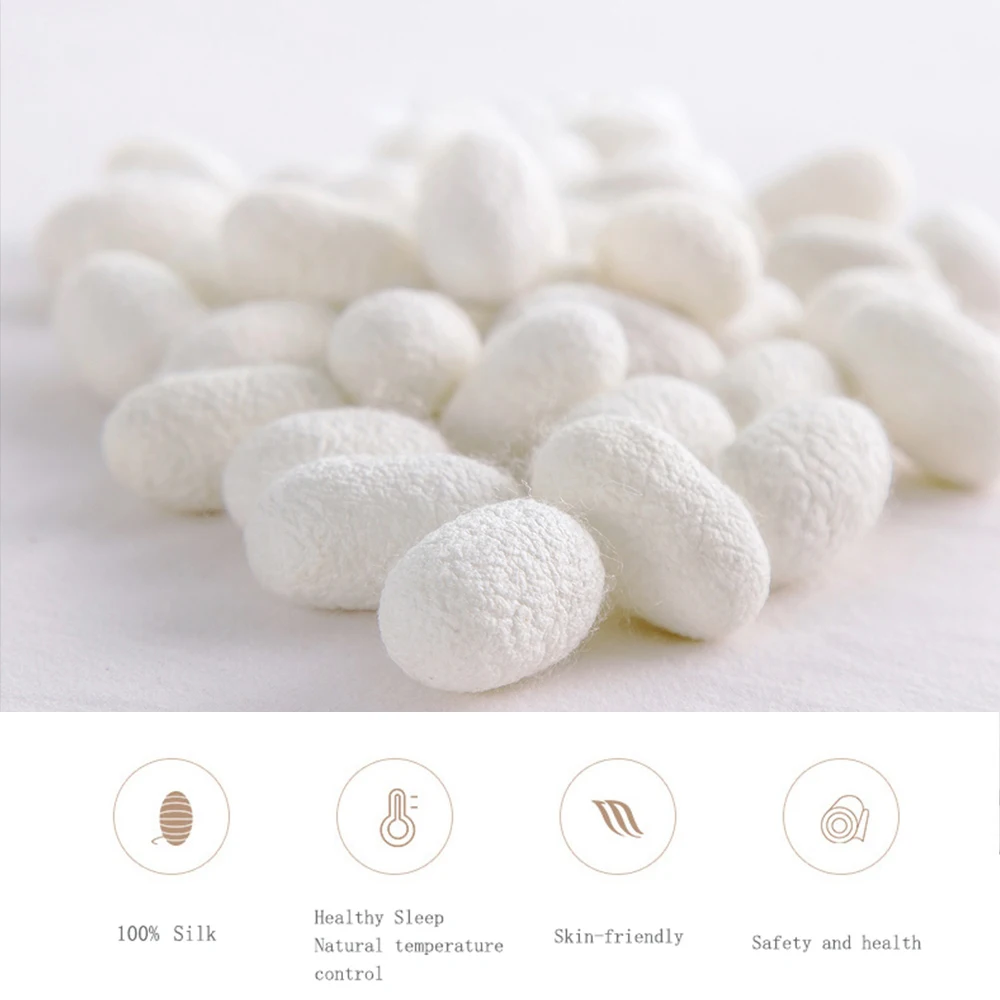
Washing Silk Sheets: Protecting Your Investment
Proper washing is perhaps the most critical aspect of silk care:
Hand Washing (Preferred Method):
* Fill a basin with cold water
* Add a small amount of specialized silk detergent or gentle, pH-neutral soap
* Gently agitate the water to distribute soap, then submerge sheets
* Soak for 10-15 minutes, occasionally moving them gently through the water
* Avoid twisting, wringing, or scrubbing
Machine Washing (If Necessary):
* Use a mesh laundry bag to protect sheets from agitator damage
* Select cold water and the most gentle cycle available (typically “delicate” or “hand wash”)
* Use minimal amounts of silk-specific detergent
* Remove promptly when the cycle completes
Products to Avoid:
* Bleach (even color-safe varieties)
* Fabric softeners
* Enzyme-based detergents
* Regular laundry detergents with harsh chemicals
* Spot treatments unless specifically formulated for silk
Washing frequency should balance cleanliness with minimizing wear. Weekly washing is typical for pillowcases (due to face oils and products), while sheets can often go 2-3 weeks between washings depending on personal preference and sleeping habits.
Drying and Finishing: Handling Wet Silk
Proper drying techniques are equally important for preserving silk’s quality:
- After washing, gently press (don’t wring) sheets between clean towels to remove excess water
- Hang sheets to air dry, ideally on a padded hanger or drying rack
- Position away from direct sunlight, which can weaken fibers and fade colors
- Keep away from heat sources like radiators, which can damage the protein fibers
- Allow to dry completely before storing or using
If ironing is necessary:
* Ensure sheets are slightly damp (or use a spray bottle to dampen)
* Set iron to the lowest silk/delicate setting (no steam)
* Place a clean cotton cloth between the iron and silk
* Iron inside-out when possible to protect the sheen
* Use gentle, smooth movements rather than pressing heavily
Many users find that properly hung silk sheets dry with minimal wrinkles, often eliminating the need for ironing entirely.
Storage Solutions: Between-Use Protection
Proper storage helps maintain silk’s quality when sheets aren’t in use:
- Ensure sheets are completely dry before storing
- Store in a cool, dry place away from direct sunlight
- Use breathable cotton storage bags rather than plastic
- Add acid-free tissue paper between folds to prevent sharp creasing
- Avoid cedar chests or mothballs, which can damage silk fibers
- Consider rotating between multiple sets to extend the life of each
For seasonal storage, placing sheets in a breathable cotton bag with lavender sachets provides natural pest protection without damaging the silk.
Emergency Care: Addressing Stains and Damage
Despite best precautions, accidents happen. When they do:
For Liquid Spills:
* Blot immediately with a clean, dry cloth (don’t rub)
* Avoid using hot water, which can set protein-based stains
* For water-based stains, spot clean with mild diluted silk detergent
* For oil-based stains, sprinkle with cornstarch or baby powder to absorb, then brush away after drying
* Rinse the affected area with cold water by holding it under a running tap
For Snags or Pulls:
* Never cut a pulled thread
* Gently work the thread back into the fabric using a needle or pin
* For more serious damage, consider professional repair services
Water Spots:
* To remove water spots, try washing the entire item
* For stubborn water marks, a very light misting with water followed by air drying can sometimes help blend the spot
Professional dry cleaning using silk-safe methods is recommended for persistent stains or significant damage.
The Final Verdict: Is It Worth It for You?
After examining the comprehensive benefits, potential drawbacks, comparative value, and care requirements of silk bedsheets, we return to the central question: are they worth the investment? The answer, unsurprisingly, depends on your individual circumstances, priorities, and expectations.
Silk bedsheets represent a significant initial investment that pays dividends in comfort, potential health benefits, and longevity—but only if those specific benefits align with your needs and values. Understanding what’s included in silk bedding sets can help you make this assessment more accurately.
Ideal Candidates: Who Benefits Most from Silk Sheets?
Silk bedsheets tend to provide the greatest value for:
- People with sensitive skin conditions like eczema or dermatitis
- Those suffering from allergies or asthma who benefit from silk’s hypoallergenic properties
- Individuals with curly, frizzy, or fragile hair prone to breakage and tangling
- Hot sleepers or those experiencing temperature fluctuations such as night sweats
- Anyone seeking enhanced comfort for better sleep quality
- Those who appreciate luxury experiences and aesthetic beauty in their surroundings
- People willing to follow proper care routines to protect their investment
The unique science behind how silk sheets regulate temperature makes them particularly valuable for those with temperature sensitivity issues, providing benefits difficult to achieve with other materials.
Full-size Silk Sheets, King Size Silk Sheets, Queen Size Silk Sheets, Twin Size Silk Sheets, Washable Silk Sheets
Price range: $95.95 through $178.37 Select options This product has multiple variants. The options may be chosen on the product page100% Silk Sheets, Green Silk Sheets, King Size Silk Bedding Set, Mulberry Silk Bedding Sets, Queen Size Silk Bedding Set
Price range: $1,246.21 through $1,615.22 Select options This product has multiple variants. The options may be chosen on the product pageEucalyptus Silk Bedding Sets, Eucalyptus Silk Sheets
Price range: $360.24 through $393.60 Select options This product has multiple variants. The options may be chosen on the product pagePink Silk Sheets, Twin Size Silk Sheets
$171.80 Select options This product has multiple variants. The options may be chosen on the product pageFull-size Silk Sheets, Pink Silk Sheets
$136.31 Select options This product has multiple variants. The options may be chosen on the product pageGrey Silk Sheets, Silk Sheet and Pillowcase Set
Price range: $88.20 through $146.64 Select options This product has multiple variants. The options may be chosen on the product page
When the Investment Makes Financial Sense
Beyond immediate comfort benefits, silk can make financial sense for those taking a longer view:
- When calculated over a 5-7 year lifespan with proper care, the per-night cost of quality silk sheets typically falls between 15-30 cents—comparable to replacing lower-quality sheets every 1-2 years
- For those who would otherwise purchase multiple specialized products (anti-allergy bedding, hair protection items, specialized skincare), silk can consolidate these functions into a single investment
- Individuals who prioritize sleep quality and understand its impact on overall health often find the investment justified by improved rest
- Those who view bedding as an important element of self-care and wellness rather than a basic necessity
The value equation improves substantially when considering potential savings on hair products, skincare items, and replacement costs for lower-quality bedding over time.
Decision Factors: Your Personal Assessment Checklist
To determine if silk bedsheets are worth the investment for your specific situation, consider:
Budget Comfort:
* Can you comfortably afford the initial investment without financial strain?
* Do you view bedding as a utilitarian necessity or an experience worth investing in?
* Are you willing to pay more upfront for potential long-term value?
Lifestyle Compatibility:
* Are you willing to follow the recommended care routine?
* Do you have pets that might damage silk with claws?
* Do children or others who might be less careful use your bed regularly?
Personal Benefit Potential:
* Do you have specific skin or hair concerns that silk might address?
* Do you struggle with temperature regulation during sleep?
* Do you have allergies or sensitivities that hypoallergenic bedding might help?
Value Priorities:
* How important is the sensory experience of your bedding to your sleep quality?
* Do you prioritize natural materials in your purchasing decisions?
* How significant is aesthetic beauty in your bedroom environment?
Your answers to these questions will guide whether silk represents a worthwhile investment for your particular circumstances.
Frequently Asked Questions About Silk Bedsheets
How long do silk sheets typically last with proper care?
Quality silk sheets can last 5-10+ years with appropriate maintenance. This longevity significantly offsets the higher initial investment compared to sheets that require replacement every 1-2 years.
Will silk sheets keep me warm enough in winter?
Yes, despite their lightweight feel, silk sheets provide excellent insulation through their natural protein structure. The warming properties of silk sheets in winter come from microscopic air pockets in the fiber that trap body heat while still allowing skin to breathe.
How can I prevent silk sheets from slipping off the bed?
Look for fitted sheets with deep pockets and strong elastic. Sheet straps or suspenders can also secure corners. Some manufacturers offer slightly textured silk or silk blends that reduce slippage while maintaining benefits.
Can I put silk sheets in the dryer?
No, machine drying is not recommended for silk sheets. The heat and tumbling action can damage the protein fibers, causing shrinkage, weakening, and loss of silk’s natural properties. Air drying is always the best option.
How do I know if I’m buying real silk or a synthetic imitation?
Real silk feels cool to the touch initially but warms quickly with body contact. It has a distinctive soft, smooth feel without being slippery or static-prone like synthetics. The burn test (burning a thread—silk smells like burning hair and leaves ash; polyester melts) is definitive but destructive.
What is the best momme weight for beginners to silk bedding?
A 19-22 momme weight offers an excellent balance for first-time silk users, providing good durability while keeping the cost more accessible than heavier weights. This range also tends to feel less slippery than very lightweight silk.
Making the Right Choice for Your Sleep Sanctuary
Silk bedsheets represent a significant investment in your sleep environment—one that delivers unique benefits impossible to replicate with other materials. From unparalleled comfort and temperature regulation to tangible benefits for skin, hair, and allergies, silk offers a compelling package of advantages for the right user.
Yet the “worth it” equation remains deeply personal. Your sleep preferences, health needs, aesthetic values, and financial priorities all factor into whether silk represents a sensible investment or an unnecessary luxury for your situation.
Quality matters tremendously in this decision. Inferior silk products rarely deliver the full spectrum of benefits that make the investment worthwhile. If you decide to proceed, prioritize proper quality indicators like appropriate momme weight, mulberry silk composition, and reputable manufacturing.
Ultimately, those who value the specific benefits silk provides and are willing to maintain these special sheets properly often find they’re more than worth the investment, transforming ordinary sleep into an extraordinary experience. If you’re ready to explore options, consider browsing our selection of silk sheets to find the perfect match for your needs.

